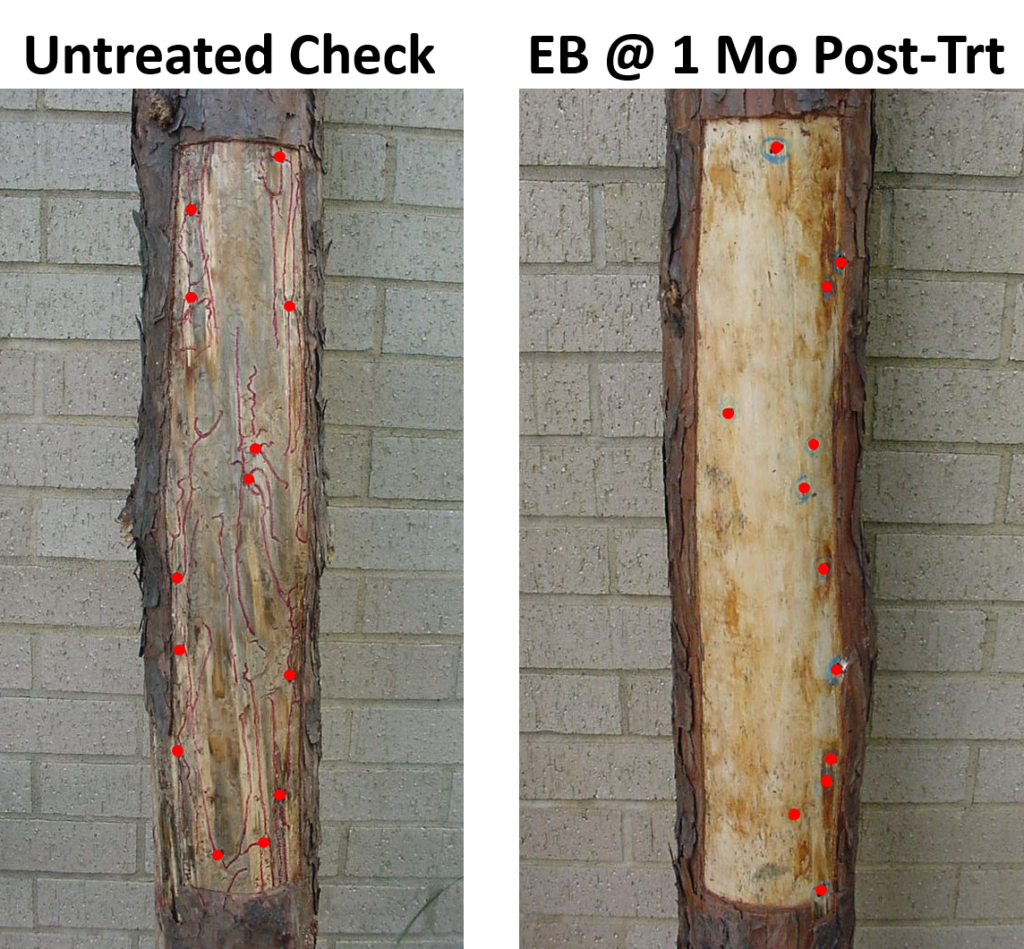Conifer bark beetles are some of the most destructive insects in urban, commercial, and natural forests. These beetles feed on the inner bark of conifer trees like the pine, spruce and fir forming tunnels under the bark to lay their eggs. Normally, conifer bark beetles prefer to attack sick or old trees because they can’t defend themselves easily. However, sometimes the beetles become so numerous that they will group up and start attacking healthy trees. With warmer and drier climates, we are seeing unprecedented bark beetle outbreaks occurring in North America, Europe, and Asia. Since 2000, some of these beetles (mountain pine beetle, western pine beetle, spruce beetle and Ips engravers) have killed 150,000 square miles of forest alone in the western United states and Canada. In addition, several species (including the southern pine beetle) are expanding their ranges farther north than ever found before. Ips engravers are more problematic in urban forests while Dendroctonus (Tree Killer) species are more of concern in natural and commercial forests.
In the past, tree protection against conifer bark beetles was largely limited to trunk/or bole sprays. Yet, efficacy is often limited by labor costs, access in remote locations, tree height, weather (rain and temperatures), and chemical duration. However, in 2004, Don Grosman (working for the Texas Forest Service at the time) discovered that trunk injection of emamectin benzoate (EB) into loblolly pine could prevent the successful attack and colonization of Ips engraver beetles. This was the first demonstration of efficacy of a systemic insecticide for protecting trees from mortality by bark beetles. Advantages of systemic trunk injections include reduced pesticide load in the area, no need for large spray equipment, little or no worker exposure, no drift and nontarget effects, and longer treatment effects (2 or more years). Additional trials have since shown excellent protection of conifers by EB (now registered as TREE-äge®, TREE-äge G4, TREE-äge R10) against Western pine beetle, Mountain pine beetle, Southern pine beetle, Spruce beetle and black turpentine beetle for 2 or more years.
All these conifer beetles carry with them associated fungi which can be pathogenic and aid the beetles in causing tree mortality. With that in mind, additional tests were conducted and showed that the addition of a systemic fungicide (e.g. propiconazole, Propizol) could improve survival of trees attacked by bark beetles in high numbers. Now with the development of more efficient injection systems (e.g. QUIK-jet AIR microinjection) and higher concentration formulations (e.g. TREE-äge R10) average-sized trees (18 inch diameter) can be treated and protected in just 5 minutes. Go ahead, save a conifer.

First demonstration of effects of emamectin benzoate (EB) on Ips engraver beetle colonization of loblolly pine logs 1 month after injection – 2004. Notice extensive galleries on the untreated check log and none on the EB-treated log.

Dr. Don Grosman, Ph. D
Technology Advancement Manager & Entomologist
References:
Grosman, D.M., R.F. Billings and W. W. Upton. 2004. Annual Report. Western Gulf Forest Pest Management Cooperative.
Grosman, D.M., R.F. Billings, W. W. Upton and J.C. Helvey. 2005. Annual Report. Western Gulf Forest Pest Management Cooperative.
Grosman, D.M., R.F. Billings, W. W. Upton, J.C. Helvey and M. Murphrey. 2006. Annual Report. Western Gulf Forest Pest Management Cooperative.
Grosman, D.M. and W.W. Upton. 2006. Efficacy of systemic insecticides for protection of single trees against southern pine bark beetles (Coleoptera: Curculionidae, Scolytinae) and wood borers (Coleoptera: Cerambycidae). J. Econ. Entomol. 99: 94-101.
Grosman, D.M., S.R. Clarke, and W.W. Upton. 2009. Efficacy of two systemic insecticides injected into loblolly pine for protection against southern pine bark beetles (Coleoptera: Curculionidae). J. Econ. Entomol. 102: 1062-1069.
Grosman, D.M., C.J. Fettig, C.L. Jorgensen, and A.S. Munson. 2010. Efficacy of two systemic insecticides for protection of western conifers against Dendroctonus bark beetles (Coleoptera: Curculionidae, Scolytinae). W. J. Appl. For. 25: 181-185.
Grosman, D.M., R.F. Billings, W. W. Upton, and B.L. Kavanagh. 2008-2009. Annual Report. Forest Pest Management Cooperative.
Grosman, D.M., M.J. Fischer, R.F. Billings, W. W. Upton, B.L. Kavanagh and L. Spivey. 2012 Annual Report. Forest Pest Management Cooperative.
Fischer, M.J., D.M. Grosman, R.F. Billings, W. W. Upton, B.L. Kavanaugh and L. Spivey. 2014. Annual Report. Forest Pest Management Cooperative.
Fettig CJ, Munson AS, Grosman DM, and Bush, PB. 2014. Evaluations of emamectin benzoate and propiconazole for protecting individual Pinus contorta from mortality attributed to colonization by Dendroctonus ponderosae and associated fungi. Pest Mgt. Sci. 70: 771-778.
Fettig, C.J., D.C. Blackford, A.S. Munson, and D.M. Grosman. 2016. Injections of emamectin benzoate protect Engelmann spruce from mortality attributed to spruce beetle for two years. J. Entomol. Sci. 52(2): 193–196.
Fettig, C.J., A.S. Munson, D.M. Grosman and D.C. Blackford. 2020. Evaluations of Bole Injections for Protecting Engelmann Spruce from Mortality Attributed to Spruce Beetle (Coleoptera: Curculionidae) in the Intermountain West. J. Entomol Sci. 55: 301-309.
